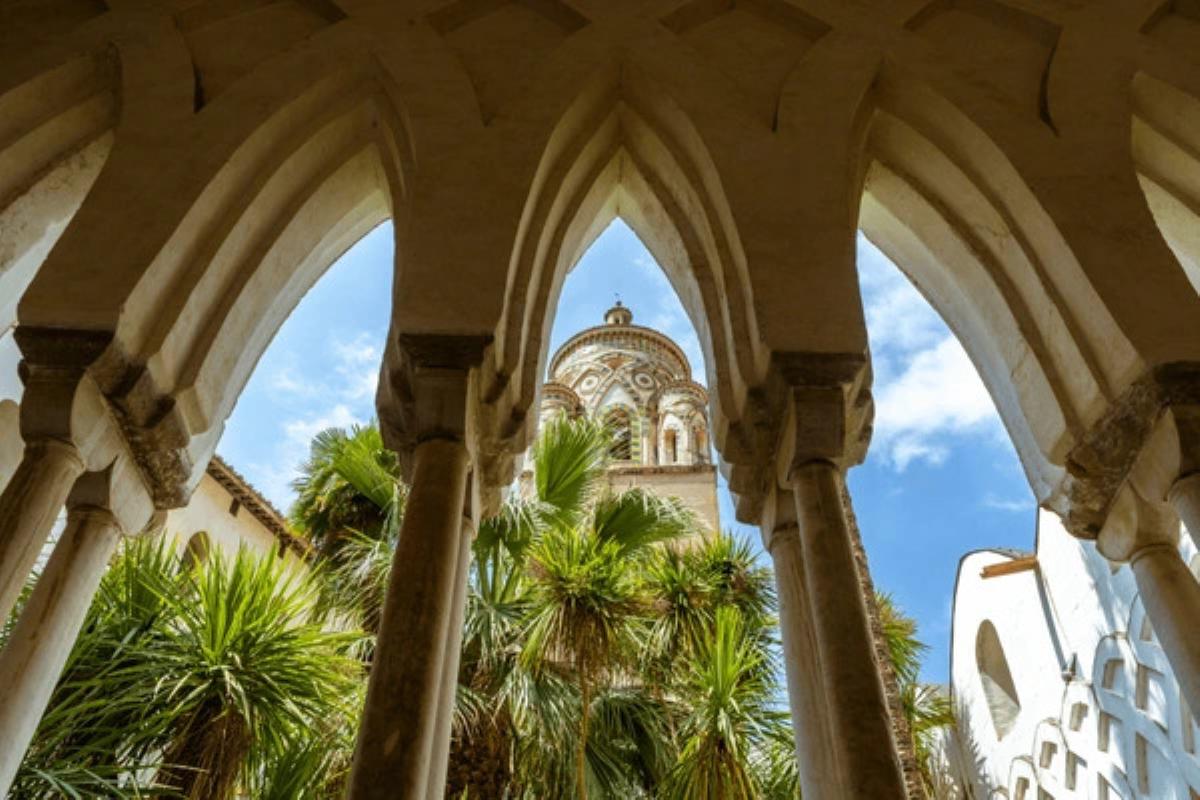The Cloister of Paradise in Amalfi
The Cloister of Paradise in Amalfi is a true hidden gem within the complex of the Cathedral of Saint Andrew, also known as the Amalfi Cathedral.
Cloister of Paradise: A Gem in Amalfi
The Cloister of Paradise is one of the most captivating places in Amalfi, located within the Diocesan Museum. Built in the 13th century, the cloister is a magnificent example of medieval architecture, featuring elegant columns and rounded arches. Its serene atmosphere is enhanced by an inner garden, making it an ideal place for contemplation and reflection. The Cloister of Paradise was constructed between 1266 and 1268 by order of Archbishop Filippo Augustariccio, originally intended as a cemetery for the nobility and distinguished citizens of the Maritime Republic of Amalfi.

Curiosities about the Cloister of Paradise
While its style is predominantly Romanesque, one cannot overlook the Arabesque influence that pervades the architecture. This captivating blend of styles reflects Amalfi's multicultural history.
Inside, you’ll find a charming garden, adorned with palm trees and surrounded by porticoes featuring slender white columns. This setting creates an atmosphere of tranquility and beauty, making the cloister an ideal place for a contemplative walk.
Don’t miss the opportunity to explore these unique details, which tell stories of art, culture, and history intertwined in the heart of Amalfi!
What to See in the Cloister of Paradise in Amalfi
I Sarcofaci
One of the main attractions of the Cloister of Paradise is the left gallery, where an impressive display of sarcophagi from noble Amalfitan families is showcased. These sarcophagi, which once held the bodies of notable figures from the local nobility, tell fascinating stories related to mythology and Christian history. Currently, five particularly significant sarcophagi can be seen, each representing important episodes:
The Abduction of Proserpina - A famous episode from Greek mythology depicting the goddess's abduction by Hades.
Romulus and Remus - The iconic scene of Rome's founders being suckled by a she-wolf, symbolizing Roman history and identity.
The Wedding of Peleus and Thetis - A significant mythological scene celebrating the marriage between the king of the Myrmidons and the sea goddess.
Sarcophagus with S-Shaped Fluting - This Roman sarcophagus, belonging to the Amalfitan Favaro family, is decorated with the cross of Amalfi and is currently displayed in the arsenal.
Sarcophagus of Archbishop Pietro Capuano - Dated 1359, it features sculptures of the Madonna, Christ, the Twelve Apostles, and the sainted bishops Blaise and Basil and is now located in the cathedral's main altar.
Additionally, there is a 4th-century Roman sarcophagus bearing the name of the decurion Publius Octavius Rufus, shedding light on local history.
Finally, at the center of the charming Arab-style cloister lies a delightful garden with palm trees, likely added only after the 1908 restoration, as the Cloister of Paradise was essentially abandoned in the early 17th century.
Basilica of the Crucifix: A Hidden Treasure in the Cloister
Hidden in the heart of the Cloister, the Basilica of the Crucifix is a genuine treasure trove of history and art intertwined with the events of the maritime city of Amalfi. Originally dedicated to the Assumption and later to Saints Cosmas and Damian, the basilica took its current name from the wooden crucifix that once dominated the high altar.
The origins of the basilica date back to the 6th century, and its history is marked by tumultuous events and periods of splendor. In the 9th century, the basilica was devastated by the Lombard prince Sicard, who plundered the relics of Saint Trofimena. However, the response to this calamity was swift: thanks to the protection of Pope Leo IV and the assistance of Duke Mansone III, the church was rebuilt and expanded, gaining the status of metropolitan cathedral in 987.
This basilica not only represents an important religious heritage but also symbolizes the resilience and culture of Amalfi. Visiting it means immersing oneself in a journey through the history, art, and spirituality of the region.
How to Reach the Cloister of Paradise
For those arriving by ferry, once disembarked at the port of Amalfi, the Cloister of Paradise is easily reachable on foot, located just a few minutes from the pier. Following the signs to the historic center, visitors can enjoy a charming walk through the picturesque streets of Amalfi before arriving at the Amalfi Cathedral, as the Cloister of Paradise is situated within the complex of the Amalfi Cathedral. Once here, simply ascend the long staircase of the cathedral and access the ticket office on the left.






